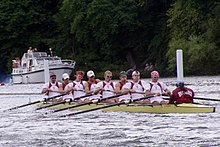User:Gingerae/sandbox
This article has multiple issues. Please help improve it or discuss these issues on the talk page. (Learn how and when to remove these messages)
|
Authenticated Key Exchange (AKE) (or Authenticated Key Agreement) is the exchange of session key in a key exchange protocol which also authenticate the identities of parties involved in the key exchange. If the protocols are done correctly, a third-party will be unable to appear as the correct party or force a key upon the agreeing parties.
Authentication
[edit]The goal of Authentication is for one party to prove it's identity to another party. Authentication protocols are susceptible to various attacks from third parties such as replay, reflection, and man-in-the-middle attacks.
Techniques to Prevent Attacks
[edit]Protocols that just require a party to declare its identity even with the use of a secret password is insecure. A third party could simply replay the message. The third party does not need to know the secret password. To prevent replay attacks, a nonce, number used only once, may be used. These prove the freshness of a message, however, a third party can still attack even with the use of a nonce in the protocol. For example:
1.a. B -> A(E): “Hi Alice, it’s me Bob” (Bob thinks he is talking to Alice when it is actually Eve) 1.b. E -> B: ”Hi Bob, it’s, me, Alice“ (Eve starts a separate session with Bob while pretending to be Alice) 2. b. B -> A(E): R (nonce) 2.a. E -> B: R (replay attack) 3.a. B -> E: E(K,R) (Bob encrypts R with Alice and Bob's shared key which proves he is Bob) 3.b. E -> B: E(K,R) (Eve replay's Bob's response and proves she is Alice)
To prevent this attack, directional keys, sequential numbers as a nonce, and time-stamps are useful. With a directional key, such as Kab, R would be encrypted with E(Kab, R). When Eve replays that message, Bob will know it is in the wrong direction, the key Kba should have been used. Sequential numbers and time-stamps prevent the replay of old messages without the other party knowing.
Key Distribution
[edit]Parties can either used a public key or symmetric keys to share information. Public key cryptography requires two different, but mathematically linked, keys. One key is public and the other is a secret only known to the individual party. The problem is with proving a public key actually belongs to the entity it says it does. Symmetric keys are a single, shared, private key between parties. Symmetric key algorithms depend on the previous agreement of a shared key. Trusted intermediaries may be used in both of these situations.
Public Key
[edit]A trusted, offline, certification authority, CA, can help prove the identity of a party with a public key. A party will tell its public key to the CA, and the CA will bind the public key to the party with a [[public key certificate|| certificate]. The CA will then [[digital signature| sign] the certificate. The authenticator will extract the other party's public key from the certificate. Category:Key management
Empacher Shells
| Bootswerft Empacher GmbH | |
| Industry | Boat manufacturer |
| Founded | Königsberg, East Prussia, Germany (1923) |
| Founder | Willy Empacher |
| Headquarters | , |
Area served | Worldwide |
| Products | Rowing boats |
| Website | www |

Empacher (company name Bootswerft Empacher GmbH) is a manufacturer of boats, in particular, racing shells for the sport of rowing.
History
[edit]Originally building sailing yachts, Willy Empacher founded his boatyard with Wilhelm Karlisch during 1923 in Königsberg, East Prussia. The boatyard was the largest east of Berlin during the 1930s. They built boats for Germany during the war, but in 1945 the family fled their town and reached Eberbach, Germany in 1947. [1]
Early Growth
[edit]Willy started a new business at the Seibert boat-yard in Eberbach repairing and making small boats. In 1952 they started producing racing rowing shells, an enterprise that has become their main business today. The business took off after Jochen Meißner won the silver medal while racing in an Empacher single scull during the 1968 Summer Olympics. They built mainly moulded cedarwood racing shells, but collaborated with BASF to produce the world's first plastic shell in 1956. Empacher built the first plastic to receive a gold medal during the 1972 Munich Olympics. This was also the first race worthy sandwich-build plastic boat.[2] This process includes using a wood frame to create the boat hull and then filling with it with composite material. [3]
Hans Empacher, Willy's eldest son, took over the business in 1970. Hans optimized the company by creating internal competition and promoting plastic boat construction. Today, brothers Helmut and Rainer Empacher are managing partners of the business. [4]
Sucesses
[edit]Empacher rowing shells are used by a large number of crews rowing in international competitions, including World Championships and the Summer Olympics.[citation needed] Boats built by Empacher are easily identified by their pale yellow color and black trim. Empacher produce every FISA-recognized racing boat category.[citation needed]
They are recognized as being one of the best manufactures for the eight, with all but the USA (who used a Hudson) using the Empacher during the 2008 Summer Olympics. In the 2012 London Olympics Empacher boats won almost all boat categories (with the exception of 3 double sculling categories won by fillipi's.) They are generally rated as the greatest racing shell builder of them all.
References
[edit]See also
[edit]External links
[edit]Category:Companies established in 1923 Category:Manufacturing companies of Germany Category:Rowing equipment manufacturers

